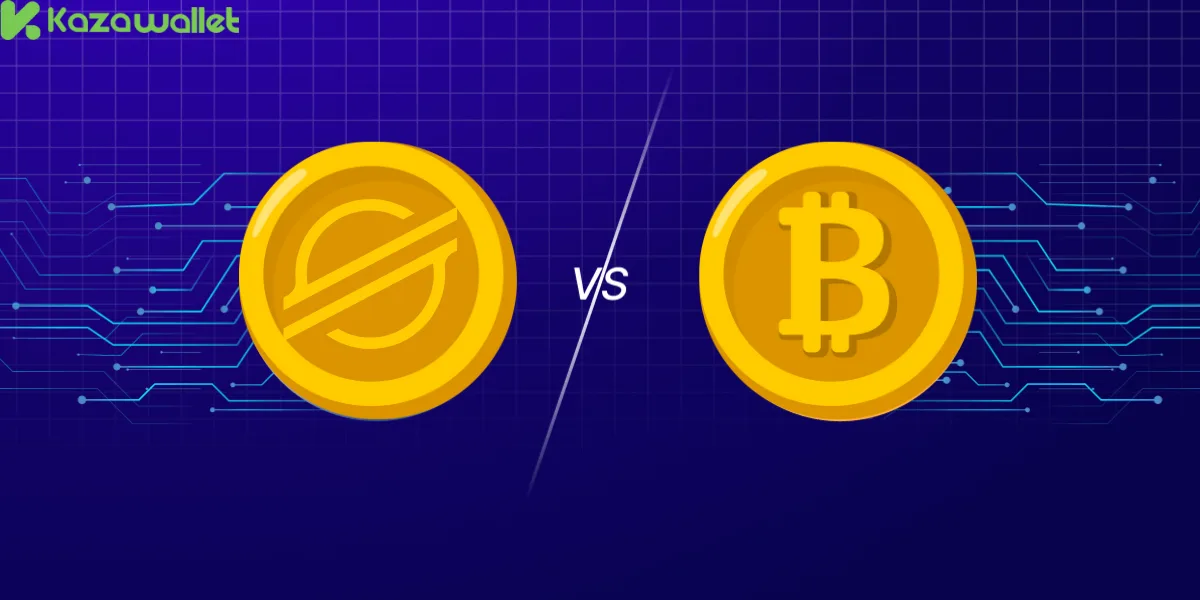The talk of “money” no longer refers only to banknotes and coins in our pocketbooks. It now involves newer digital assets stored and transferred on the web.
Among all the options available, Bitcoin and Stellar have emerged on the horizon. Bitcoin is a paradigm shift in the very idea of money itself, an effort to redefine the global financial system.
Stellar focuses on practical solutions for everyday problems in cross-border payments. Though on first impression the two cryptocurrencies may seem to have a similar purpose, differences extend beyond technology and use.
But what is Bitcoin vs Stellar? Here we will explore in greater detail the differences between Bitcoin and Stellar and how they differ from each other and the risks associated with each.
What is Bitcoin?

Bitcoin is the world’s first digital currency and was launched in 2009 by an anonymous individual or group of individuals using the name “Satoshi Nakamoto.”
One of the primary purposes of creating Bitcoin was to bring forth a payment system independent of any centralized organization, such as banks and governments.
Bitcoin operates on a process called “blockchain,” a technology that ensures transparency and security by keeping all transactions in an immutable public ledger.
Although Bitcoin started out as the first cryptocurrency, it is now employed for reasons other than payments. It acts as an investment instrument for most people and companies.
However, its huge price volatility makes it a risky asset. Bitcoin is the first “digital asset” and a benchmark by which all other cryptocurrencies are judged.
What is Stellar?

Stellar (XLM) is an open-source payment network and cryptocurrency founded in 2014 by Jed McCaleb, also the co-founder of Ripple.
Lumens, the abbreviated term for XLM, is the native cryptocurrency of Stellar and specifically designed to facilitate cross-currency transactions between traditional and digital currencies.
Stellar’s most notable feature is the fact that it isn’t just a payment network but a cross-currency bridge and an easily accessible day-to-day tool.
Additionally, Stellar focuses on financial inclusivity and targets people who lack access to traditional financial services.
Though less mainstream than Bitcoin, Stellar plays a significant role in the fintech sector. It was founded to facilitate low-cost and fast cross-border money transfers and is best suited for cross-border commerce.
One of the differences between Bitcoin and Stellar is that Stellar differs from Bitcoin in its mission of providing real solutions to everyday financial transfer problems, unlike Bitcoin’s mission of acting as an alternative to the traditional financial system.
Besides this, Stellar also has partnerships with various big financial institutions, such as MoneyGram and IBM, enhancing its adoption and utilization in business circles.
USDT vs Stellar: A Comparison of Risks and Stability
Bitcoin vs Stellar: The Differences Between Bitcoin and Stellar

Though Bitcoin and Stellar are cryptocurrencies based on blockchain technology, they have a number of differences between them. Let us discuss the differences between Bitcoin and Stellar:
Major Purpose:
One of the differences between Bitcoin and Stellar is that Bitcoin exists in order to facilitate an independent system of money free from any centralized organization. It is most commonly viewed as an inflation hedge and/or a long-term store of value.
Conversely, the major function of Stellar is to enable low-cost and speedy cross-border payments, and thus it is more practical in nature for everyday use.
Stability
It is less stable compared to other currencies because of its huge price volatility. Bitcoin’s value can fluctuate wildly in a very short time and thus isn’t as appropriate for daily use.
Conversely, albeit less stable than traditional currencies, Stellar offers less volatility than Bitcoin and is therefore suitable for business transactions and transfers.
Technology
Another one of the differences between Bitcoin and Stellar is that Bitcoin follows a straightforward blockchain protocol where transactions are verified by a process of “Proof of Work,” an energy-consuming process.
Stellar features another sort of consensus mechanism called “federated consensus,” making the process of processing transactions faster and energy-efficient.
Supplies
One of the differences between Bitcoin and Stellar is that Bitcoin exists in only 21 million coins total, and this limits the number available and affects its market value.
Stellar, by contrast, had approximately 100 billion coins in existence at launch and releases a percentage annually to avoid overscarcity. This strategy makes Stellar better suited to the realities of financial transactions in the real world.
Use
Bitcoin is widely employed as an investment and as a store of value, and yet it is struggling to be adopted as an everyday payment instrument.
Stellar is typically used for cross-border payments and business transactions, but is becoming increasingly suitable for everyday use.
Decentral
Bitcoin is a prime example of total decentralization; there isn’t any entity controlling the network. All participants contribute to the verification of transactions, and as such, it becomes more transparent and secure.
Though Stellar enjoys some degree of decentralization, there are portions of the network controlled by a non-profit entity called the Stellar Development Foundation, and thus it isn’t as decentralized as Bitcoin.
Acceptance and Adoption:
Stellar, while less widely known than Bitcoin, but with strong alliances with major financial institutions, holds greater influence in the cross-border transfer space.
Bitcoin vs Stellar: Risks Involved

Risks Associated with Bitcoin:
- Price Volatility: Bitcoin is characterized by sharp fluctuations in its value, experiencing significant price changes in short periods. This volatility makes investing risky, especially for investors who prefer stability or have low-risk tolerance.
- Fraud Risks: The Bitcoin market is not immune to scams and fraud. Unreliable platforms may expose investors to scams by offering fake interfaces or counterfeit coins, leading to significant financial losses.
- Security Issues: Bitcoin is vulnerable to hacking and theft, especially if digital wallets aren’t properly secured. Losing a private key or having a wallet compromised makes recovering funds nearly impossible.
- Regulatory Environment: Bitcoin operates in an unstable regulatory environment, where changes in laws or government bans can impact its value and acceptance. This creates uncertainty for investors, particularly with differing policies across countries.
- Technical Flaws: Despite significant advancements in blockchain technology, it’s not free from security vulnerabilities or technical flaws that could be exploited for cyberattacks.
- Impact of Global Events: Bitcoin is sensitive to global political and economic events. Economic crises, political decisions, or even media statements can cause significant price fluctuations, making it less stable than traditional assets like gold or fiat currency.
- Global Trends: Despite challenges, some countries are adopting Bitcoin as part of their financial strategies. For example, Germany has begun accumulating Bitcoin reserves, while other countries like the US and Russia are considering similar steps.
Risks Associated with Stellar:
- Centralized Control: The Stellar Development Foundation holds a significant percentage of XLM, exposing the network to the risk of centralized control by a single entity. This situation resembles XRP, raising regulatory concerns and threatening decentralization.
- Few Validators: The number of nodes verifying transactions on the Stellar network is relatively small, with most linked to the Stellar Development Foundation. This increases the risk of manipulation or hacking and reduces the network’s strength.
- Small Development Team: Stellar’s development relies on a relatively small team, potentially slowing development and reducing the network’s ability to adapt to technical challenges or rapid changes in the cryptocurrency market.
- Lack of Incentives: Insufficient financial incentives discourage individuals from running nodes on the Stellar network, potentially leading to fewer nodes and increased concentration in the hands of a limited number of entities.
- Regulatory Concerns: Due to similarities with XRP, which faces legal challenges, Stellar may face similar regulatory risks. This could lead to restrictions on its use or even bans in some countries.
- Lack of Transparency: At times, the Stellar team’s responses to technical issues have lacked transparency, raising doubts about project management and credibility.
In the end
The world of digital currency is fraught with challenges and prospects, and all cryptocurrencies have different advantages and risks.
Before you decide between them in the Bitcoin vs Stellar, it is useful to have an idea of the nature and intent of such currencies. Regardless of your choice between the financial revolution of Bitcoin and the practical alternatives of Stellar, the future of the digital age promises limitless possibilities.
And don’t forget how much simpler it is to work with cryptocurrencies like USDC, Tron, Bitcoin, and others thanks to Kazawallet. With the wallet, you enjoy the convenience of buying, storing, depositing, and withdrawing cryptocurrencies in an easy and secure process.
 Blog Kazawallet
Blog Kazawallet




